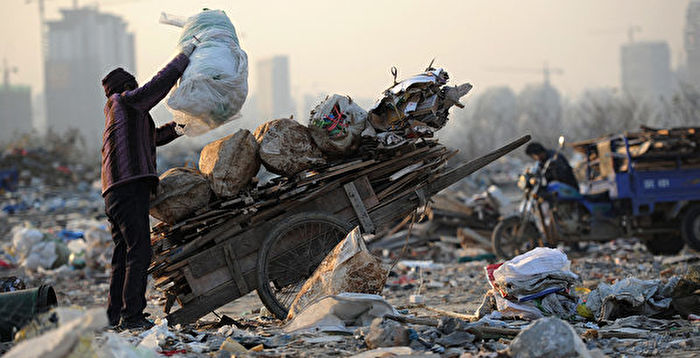[The Epoch Times, April 20, 2022](The Epoch Times Special Report Reporter Jiang Feng Comprehensive Report) Two authoritative reports on China’s wealthy people released recently show that the sum of wealth of China’s wealthy households has reached 1.6 times China’s GDP. The top 2% of the pyramid account for 80% of society’s wealth.
On April 14, the Hurun Wealth Report released by the Hurun Research Institute showed that as of January 1, 2021, wealthy Chinese families (with assets exceeding 6 million yuan, or US$942,000) had total wealth of 1.6 million yuan. 100 million yuan (25.1 trillion U.S. dollars), which is 1.57 times the total GDP of China in 2020. Moreover, the wealth of the rich increased by 9.6% over the previous year, outpacing the GDP growth rate of 2.2% in 2020.
Among these wealthy households, the number of “high-net-worth households” with total wealth of 10 million yuan ($1.57 million) reached 2.06 million, a 2 percent increase from the previous year. The number of “ultra-high net worth households” with total wealth of 100 million yuan ($16 million) reached 133,000, a 2.5 percent increase from the previous year.
Among them, Guangdong, Beijing and Shanghai gathered 300,000, 298,000 and 262,000 “high net worth families” respectively, accounting for 42% of the national total.
The “China Merchants Bank Annual Report” released in March this year shows that the wealthy (average daily assets of more than 10 million yuan, or US$1.569 million) accounted for 0.07% (calculated based on 1.4 billion people, about 980,000 people), holding 31.54% of the assets, the per capita asset amount is 27.8043 million yuan (4.364 million US dollars).
The middle class (average daily assets of more than 500,000 yuan, or US$78,000) accounted for 2.05% and held 50.58% of assets, with per capita assets of 1,533,100 yuan (US$240,000).
Ordinary people (with an average daily asset of less than 500,000 yuan, or US$78,000) accounted for 97.88%, and only 17.87% of the assets were held, and the per capita asset amount was only 11,400 yuan (US$1,800).
It can be seen from the above that in China, 2% of the population (according to 1.4 billion people, about 28 million people) account for 80% of the wealth of society.
A 2014 study by the University of Michigan showed that the gap between the rich and the poor in China has surpassed that of the United States and is among the highest in the world. In 2010, the Gini coefficient of household income in China was 0.55, compared with 0.45 in the United States.
In September 2021, Ning Jizhe, director of the National Bureau of Statistics of the Communist Party of China, stated that the Gini coefficient of mainland China in 2020 will be 0.468. According to the United Nations Development Programme, a Gini coefficient of 0.4 is a “red line” for income distribution gaps.
The so-called Gini coefficient is an indicator for judging the fairness of annual income distribution defined by the Italian scholar Corrado Gini in the early 20th century based on the Lorenz curve.
According to the standard set by the United Nations Development Program, a Gini coefficient of more than 0.4 means polarization between the rich and the poor.
In May 2020, Chinese Premier Li Keqiang revealed at a press conference that China’s per capita annual income is 30,000 yuan ($4,700), “but 600 million people earn only 1,000 yuan ($156.9) a month, and 1,000 It may be difficult to rent a house in a medium-sized city.”
One of the real reasons for the gap between the rich and the poor in China is the corruption of CCP officials. As early as 2010, Wang Xiaolu, deputy director of the National Economic Research Institute of the China Reform Foundation, admitted that money and power transactions and the use of power for personal gain are common in China, which includes a lot of “hidden income”.
Wang Xiaolu disclosed at the time that the official Gini coefficient omits a large number of undisclosed “hidden income”, so it cannot accurately reflect the income gap. If “hidden income” is taken into account, the actual per capita income of the highest-income group of Chinese urban households in 2008 was 26 times that of the lowest-income group, which was much higher than the officially announced 9 times; the actual per capita income of the highest-income group of urban households The per capita income is 65 times that of the lowest income group of rural households, and far higher than the official 23 times.
A 2015 study by Liu Qiongzhi and Luo Qin from Wuhan University’s School of Economics and Management showed that if hidden income is taken into account, the Gini coefficient of China’s income in 2011 will reach 0.53, which is significantly higher than the 0.477 published by the National Bureau of Statistics.
Another fact that mainland scholars have not dared to expose is that the CCP princelings use family power and nepotism to control the country’s economic lifeline and divide up the country’s wealth.
In 2014, the International Consortium of Investigative Journalists found that nearly 22,000 customers from China or Hong Kong were hiding their wealth in offshore financial centers. Among these people were at least five relatives of current or former members of the Politburo Standing Committee of the CPC Central Committee at the time.
Responsible editor: Lian Shuhua#
